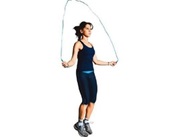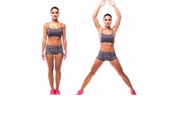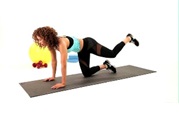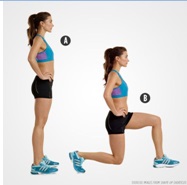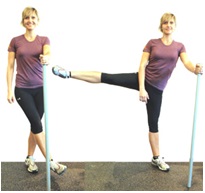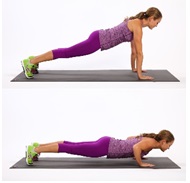In general, the following warm-up structure can be offered regarding the personal characteristics of a client and her preferences. The main factors that impacted the choice of exercises are low-energy levels and interest in strength training. Additionally, Joy’s free periods and available time were considered. The whole warm-up session is shot as it takes 6 minutes, but it can be viewed as sufficient enough to prepare her body for the following training and help to avoid serious traumas or injuries.
Skipping is used to increase core body temperature that will lower the activation energy rates of chemical metabolic reactions, reduce muscle viscosity, and increase the sensitivity of nerve receptors. The body will also gradually prepare for the activity. Moreover, synovial fluid will start to lubricate joints, and it will help to avoid traumas.
The primary rationale for using jumping jacks remains similar to the previous one. This basic exercise helps to make muscles more flexible, make the heart work faster, and be ready for the workout session presupposing weight train. 30 repetitions during 1 minute will be enough for Joy regarding the state of her health and the overall purpose of the given plan.
The stretching phase starts with the hip extensions, 10 reps, 2 seconds for each. The given step is vital for the whole session as exercise belonging to it helps to make muscles more pliable and ready for stress. At the same time, hip extensions are sufficient for individuals who will engage in weight train as legs are prepared for new exercises.
Lunges are selected as a useful element of active stretching. Before the main workout session, Joy has to prepare her muscles and guarantee that they have enough blood and oxygen. Moreover, lunges help to boost the effectiveness of the whole process because of the better work of various muscles and their preparedness for prolonged periods of physical activity. Lunges can be easily performed by Joy; however, at the same time, they are useful in stretching.
The final exercise of a stretching phase is sided leg swing of 5 repetitions of each leg, 20 sec total. The rationale for the use of this method is its positive effect on muscles and significant reduction of possible hip traumas, injured muscles, and contributes to better flexibility of limbs. In such a way, the stretching section should be ended by this very exercise as it helps to move to the next step.
Finally, the warm-up session should be ended by push-ups as an intensity connector. There are 3 sessions, 7 repetitions each, 1 minute total. Push-ups are rather difficult exercises that will make the patient ready for the following workout and make the main groups of muscles work better, which is vital for the whole workout session.
In such a way, the following warm-up session consisting of outlined exercises can be recommended for the patient as it will help to increase the body temperature, make muscles more flexible, improve the blood flow, and boost outcomes. Additionally, the warm-up will improve the mental preparedness of the client for the would-be session. The timeline is also appropriate for a client as the proposed schedule is flexible and does not demand much time.
Cool-Down
The cool-down is also important for any physical activity as it has several positive effects on the body. First, this phase can help the body to recover after stress activity and enter its normal state. During this period, the heart rate becomes similar to its pre-exercise showings. The blood pressure becomes stabilized and also becomes normal. If a person stops too fast and avoids the cooling-down phase, he/she might feel sick and demand special help. Additionally, during this very period, the generation of lactic acid becomes reduced. In such a way, warming up and cooling down can be considered two opposite kinds of activity vital for a person who performs physical exercises. As against the first aspect, which is aimed at the preparation of the body for stress, increase in temperature, blood flow, and pressure, the second phenomenon is needed to make the transition from active to inactive phases less stressful and avoid fast breaks that might precondition substantial harm to the health. Muscles should be returned to their standard resting lengths, which will speed up the recovery. Coaches and practice research do not have a single approach to this issue; however, it phase should be present in all sessions. Additionally, cool-down does not presuppose a specified quantity of repetitions or some stretching time. The whole course should be about 5 – 7 minutes to guarantee that the body will be able to recover.
For the given health, the following C-Do activities can be offered:
- 3 minutes of exercising at a lower intensity. Will help to focus on deep breathing and return to a normal heart rate.
- Stretching. This phase is useful both during the warm-up and cool-down periods. During the C-D phase, long hold free static and PNF stretches are primarily used. PNF is employed to modify neuromuscular processes and the response of receptors.
- Walking. A classic and one of the most effective C-D exercises that ensure a gradual transition from active to passive phases. After the high level of physical load, a walk can help to restore the usual heart rate, aspiration, blood pressure, and temperature. Another advantage that it is easy to perform and does not demand any additional activity. For this reason, it is recommended for Joy.
Barriers and Facilitators
Several facilitators should be mentioned regarding the proposed program. Thus, the accessibility of equipment can be taken as one of the advantages of this program. The nature of all warm-up activities listed above presupposes that there is no need for any complex or expensive equipment. All exercises of the stretching phase can be performed at home by using a rug and some elements of furniture. For more complex activities that include strength training, some additional equipment might be needed; however, it can be found in any gym, which proves the fact that the accessibility of equipment is one of the facilitators.
In many cases, clients might fail to engage in physical activity because of the lack of knowledge about the exercises that might help them to improve their state and the absence of the needed equipment. It might serve as a serious barrier to recovery and training. However, in this case, the simplicity of the offered schedule and elements of the warm-up phase demonstrate that the accessibility of tools can serve as a facilitator by providing the person with an opportunity to engage in the outlined activities and feel better. Additionally, the recommended exercises are not difficult, and their basic description will be enough to acquire the idea of how to do them.
One of the possible strategies to guarantee that the given aspect will serve as a stimulating factor presupposes the correct assessment of the current client’s needs and available resources such as time and money. Regular physical exercise might be unaffordable for individuals because of their inability to pay a coach or buy a membership. Additionally, because of work and family issues, the person can fail to devote time to activities if they are too lengthy. Communication with a client to figure out the best possible approach can help to solve this very problem and design the action activity plan that does not demand any specific equipment, time, and can be affordable.
